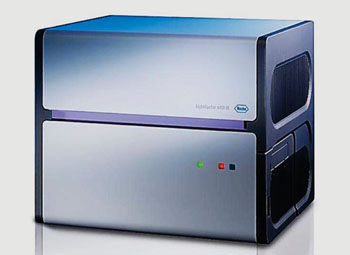Circulating MicroRNAs Predict Future Fatal Myocardial Infarction
By LabMedica International staff writers
Posted on 13 Jul 2016
Coronary heart disease is the most common cause of death, and the number of individuals at risk is increasing and to better manage this pandemic, improved tool for risk prediction, including more accurate biomarkers are needed.Posted on 13 Jul 2016
There have been several attempts during the last years to improve the risk prediction calculators by adding new bio markers. Some calculators add information of an inflammation marker in blood called C-reactive protein (CRP) or a diabetic marker called glycosylated hemoglobin (HbA1c), but still there is a need for new cardiovascular bio markers that could complement the assessment of traditional risk factors, to identify the individuals at risk with greater precision than today.

Image: The LightCycler 480 real-time PCR system (Photo courtesy of Roche).
Scientists led by those at the Norwegian University of Science and Technology (Trondheim, Norway) performed a prospective nested case-control study with 10-year observation period and fatal acute myocardial infarction (AMI) as endpoint. In total, 179 micro ribonucleic acids (miRs) were quantified by real-time polymerase chain reaction in serum of 112 healthy participants aged 40 to 70 years, 56 who either suffered from fatal AMI within 10 years, or 56 who remained healthy (risk factor-matched controls). Candidate miRs were validated in a separate cohort of 100 healthy individuals.
Standard biochemical analyses were performed on fresh venous non-fasting blood samples including glucose, high-density lipoprotein cholesterol (HDL-C), triglycerides and serum creatine using reagents from the same manufacturer (Abbott Diagnostics, Abbott Park, IL, USA). Total RNA was extracted from serum using the miRCURYRNA isolation kit for biofluids (Exiqon, Vedbaek, Denmark). The amplification was performed in a LightCycler 480 Real-Time PCR System (Roche, Basel, Switzerland).
Twelve miRs were differently expressed in cases and controls in the derivation cohort. Among these, 10 miRs differed significantly between cases and controls in the validation cohort. The team identified gender dimorphisms, as miR-424-5p and miR-26a-5p were associated exclusively with risk in men and women, respectively. The best model for predicting future AMI consisted of miR-106a-5p, miR-424-5p, let-7g-5p, miR-144-3p and miR-660-5p, providing 77.6% correct classification for both genders, and 74.1% and 81.8% for men and women, respectively.
Anja Bye, PhD, the first author of the study, said, “"For all bio marker studies, replication of the results in new studies is essential to determine the strength of the biomarkers, and to evaluate the potential use in a clinical setting. This is why we have initiated a new study, in collaboration with Karolinska Institutet, to further test these microRNAs in new participants from the HUNT study.” The study was published in the August 2016 issue of the Journal of Molecular and Cellular Cardiology.
Related Links:
Norwegian University of Science and Technology
Abbott Diagnostics
Exiqon
Roche














